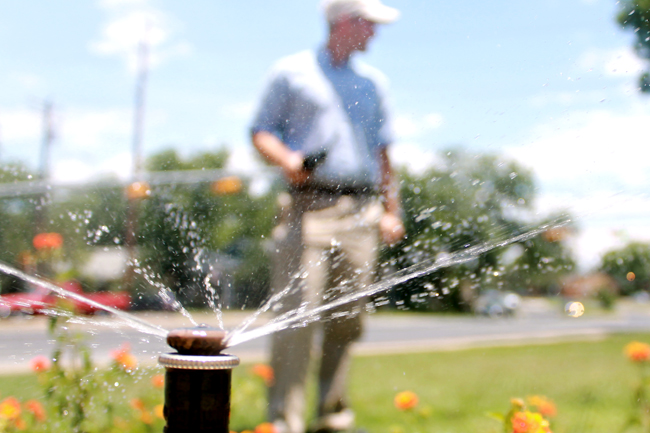Markus Hogue can turn on any sprinkler on campus with a few clicks from his office in Facilities Complex Building 8. At his desk, Hogue can watch as water data comes in, something he can spend six hours of the day doing. Hogue has spent the last year helping install and program a new campus-wide irrigation system that went live this April. The system is a one of the kind in the United States. New data released Friday shows the University saving 3.8 million gallons of water in the three months since, something that has attracted the attention of the city of Forth Worth, NASA’s Jet Propulsion Laboratory and Massachusetts Institute of Technology. But Hogue says he is not a celebrity. At least not yet.
To address costly issues of water conservation, as well as breaks and non-existent communication methods in the prior watering system, the University changed its watering methods in April with the completion of a central irrigation system. This new system has the ability to track gallon usage, detect breaks, keep track of rainfall and track water evaporation as it happens. It can be operated and monitored from either a single computer, a smartphone or a remote control — things the old irrigation system could not do. And because of these features the new system has saved millions of gallons of water along with hours of manpower.
“It is unbelievable,” said Hogue, who is UT’s program coordinator of Irrigation and Water Conservation. “It is telling me everything.”
This new central irrigation system is being used in part with a pilot program with the city of Austin. The pilot program is allowing properties to water within a water budget instead of specified days and times. Properties have less restrictions on when they can water — as long as they stay within these water budgets.
Jacob Johnson, Austin’s conservation program specialist, said the city is currently working with 16 different properties including the University, but hopes to expand to 90 by the end of the two-year pilot program. Johnson also said the current assigned water budgets were set at 15 percent less than what they would normally be because of the drought. But Hogue said the University was still watering under budget thanks to both the new central irrigation system and rainfall in early May.
Since the project’s completion, the irrigation systems are currently checked daily instead of monthly. With the new system, Hogue said the University has benefited in both research and conservation.
“It’s one of the top-of-the-line systems out right now,” Hogue said. “In the state there are a few places using a central system. But nobody is using them to what we’re doing. We’re actually collecting data, sharing it with places and trying to help conserve.”
Hogue said his favorite feature of the new irrigation system is its ability to detect high flows when more water is coming out of a zone than the computer expects there to be.
“In the old system, it wouldn’t have shut off,” Hogue said. For hours, water could leak from sprinklers before ever being detected. “Now, it immediately shuts off the zone, flags it and lets me know.”
In the event of a high flow, the system detects it immediately, shuts off the zone and sends out an alert to Hogue.
Hogue said this is an important part of the system considering how much foot traffic the campus gets.
“We have 75,000 people walk on campus almost every day during the [fall and spring],” Hogue said. “They kick [sprinkler] heads, they run over stuff, damage gets done. So that’s why that flow system is such a vital aspect.”
Hogue said the ability for the system to detect flow control has saved the University approximately $27,000 in its first three months. And that is just the flow control feature. In March and Apil, Hogue said there were 330 high flow alerts, which would have cost the University 2.6 million gallons of water if it were not for the new system.
The system is also able to determine how much water is needed based on climate. The system has two Evapotranspiration Detectors (ETs) that measure how much water is being evaporated from the soil due to wind and heat factors.
“That amount comes into the program and it either gives us more water or less water based on what is the actual need, making the system more efficient,” Hogue said. “We’re saving a bunch off that.”
For example, most sprinkler systems are set to run on certain time intervals. But with the ETs, the central irrigation system can run as long or as short as it needs to. Hogue said Facilities Services will not know exactly how much is being saved from ET data until a full season is complete.
Three rain buckets on campus operate within the new irrigation system as well and Hogue said the buckets are doing more than just measuring rainfall. They are calculating how much water the soil is receiving by rainfall and determining how much less water needs to be put out by the irrigation system.
“So say we get an inch of rain in one hour,” Hogue said. “The ground can only absorb 20 percent of that. So the program goes through and only takes 20 percent of that one inch, and it uses it to calculate it into the system and says: ‘Okay, we’re going to run half an inch that day, we already got .2 inches already down, we only need to water for .3 more.’”
Hogue said more than 18,000 sprinkler heads were changed, making a switch to a rotator-type nozzle, which waters more slowly and results in less runoff and waste.
“The nozzels are gorgeous to watch, I love them, they are mesmerizing,” Hogue said. “There is almost no misting in these; you are wasting no water in it.”
When it comes to benefiting from the system, Luis Garza Jr., Assistant Manager of Irrigation and Installation, said irrigation managers have to stay within their assigned budgets.
“The only way you can make this work and save water is you got to have a budget, you got to have a timeline and you have to stick with it,” Garza said. “And you have to monitor it. You can’t just use it as an on and off button.”
Hogue said he is trying to promote the central irrigation system to institutions who may benefit. Along with receiving calls about the system, Hogue has been asked to serve as a health and service alternate on the Texas Advisory of Water Council.
“This thing is an easy retrofit to any system out there, to get it on when one person can manage and watch it,” Hogue said. “One person could manage all the parts in the state of Texas. They could sit at one computer and manage all the parts, and then send reports out to the guys in the field.”
But Hogue said they are not just using this information to report back to the city, but are sharing it with others and hoping systems like UT’s will be adopted elsewhere.
“We want people to know about this so they can work on their systems and save water,” Hogue said. “If we take all this knowledge and keep it to ourselves, we’re not bettering anyone.”
But it hasn’t been picked up elsewhere. At least, not yet.





















